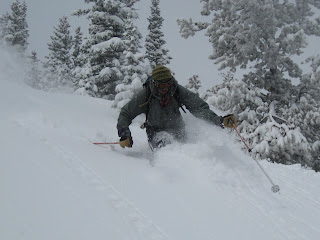After checking the weather, we opted for a Tuesday approach, Wednesday summit of Snowmass Mountain near Aspen. There are seven 14ers in the Elk Range, and Snowmass was the only one I hadn't climbed. Combine that with the notion that I wanted to ski the largest continuous snowfield in Colorado, and you have a recipe for a spring ski trip.
We left the Denver area at about 0730 on Tuesday and were near the trailhead by 1100. In attempt to drive the final half mile of the road to where the trailhead is, I succeeded in getting my 4-Runner stuck in the partially snow-covered road. By 1200, we were hiking/skiing towards our intended destination for the night, Snowmass Lake.
The first 6 miles of the approach were brutally variable. We would literally ski for a few minutes, hike over bare trail for a few minutes, and repeat. The inefficiency inherent in doing this was very slow and frustrating, but it was better than postholing.

Jeff in the process of adventure skinning
We decided to camp near some lakes at 10,200 feet in order to set up camp and filter water before dark.

Campsite at about 10,200 feet
An early start the next morning put us at Snowmass Lake (3000 feet below the summit) just as the sun was beginning to light up Snowmass Mountain and the surrounding peaks.

Snowmass Peak (left), Hagerman Peak (kinda hidden behind Snowmass Peak), and Snowmass Mountain (center, distant)
From the lake, we pretty much took a straight line (due west) toward Snowmass Mountain. We were able to skin all the way to about 200 feet below the summit, at which point we cramponed up some steep snow and ended up on the summit ridge just north of the summit. As it was getting late in the day, I took off to make sure I could summit in time to safely ski down. Jeff ended up summitting a little over an hour after me.

Jeff nearing the summit ridge
Immediately after gaining the ridge, the wind that had been blowing all day on the other (west) side of the mountain made itself apparent. As usual when in the wind, the skis on my back went immediately into sailboat mode. I found myself crawling at a couple points along the ridge in hopes that my descent would be less rapid and with my skis on my feet instead of my back.
I reached the summit a little before 1100. Up to this point, I had anticipated a ski descent from the summit proper. Turns out this would have been possible, but I opted for a flatter, 50ish degree line with a safer run-out that started just south of the true summit. The crux of skiing this line was getting the skis on. The knife edge ridge left little room for such activities.

Me on the tiny little starting 'platform'

Finishing the steep upper section
Ideally, we would have summitted earlier and descended earlier when the snow wasn‘t quite so soft. As it was, the fresh snow from a day or two earlier was in the process of rapidly consolidating and made for some super fun turns in a suspect snow pack with a safe run-out.

Jeff at the starting gate (and me in the background)
Granted, skiing this mountain involves a fairly rigorous approach, but I still couldn‘t believe that there were no other ski tracks on the mountain. The just over 3,000 vertical foot descent from the top to Snowmass Lake took us only a few minutes. After the initial steep section near the top, the rest of the ski was mellow, fun, and as fast as you wanted it to be. At one point on the decent I got a little overconfident, which resulted in a d-dunk-d-dunk (this is where you leave a discontinuous crash track, where each successive crater symbolizes alternate head-foot-head-foot contact points).
Back at camp we filtered some more water, packed up, and prepared for the deproach. Prior to the trip, I had envisioned a quick ski back down the trail to the car. This was not to be. As it turned out, the most efficient method of travel was to put the skis on the back and posthole. I never thought I‘d say that in a million years. I made it back to the car at 8:45. Jeff rolled in an hour later, making it 18 hours since we left camp, headed for the summit.
As usual, the views in the Elks were spectacular. We didn‘t see another person the entire time we were out.

The Maroon Bells and Pyramid Peak (amongst many others :-)












